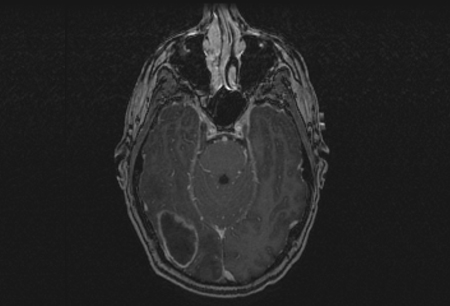Resumen
Definición
Anamnesis y examen
Principales factores de diagnóstico
- male sex
- age <30 years
- meningismus
- headache
- cranial nerve palsy
- positive Kernig or Brudzinski sign
- fever
- increased head circumference (infants)
- bulging fontanelles (infants)
Otros factores de diagnóstico
- neurological deficit
- papilledema
Factores de riesgo
- sinusitis
- otitis media
- dental procedure/infection
- meningitis
- recent head and neck surgery or neurosurgery
- congenital heart disease
- endocarditis
- diverticular disease
- hereditary hemorrhagic telangiectasia or arteriovenous malformation
- diabetes mellitus
- HIV or immunocompromise
- intravenous drug use
- chronic granulomatous disease
- hemodialysis
- birth prematurity
- cystic fibrosis
Pruebas diagnósticas
Primeras pruebas diagnósticas para solicitar
- CBC
- serum erythrocyte sedimentation rate (ESR)
- serum CRP
- serum PT, PTT, and INR
- blood culture
- MRI with contrast
- CT head with and without contrast
- ultrasound head (infants)
Pruebas diagnósticas que deben considerarse
- serum toxoplasma titer
- magnetic resonance spectroscopy (MRS)
- lumbar puncture (LP) with cerebrospinal fluid (CSF) analysis
- CT chest, abdomen, and pelvis
- bone scan
- mammogram
Algoritmo de tratamiento
presumed brain abscess
suspected or confirmed bacterial etiology
confirmed fungal etiology
suspected or confirmed parasitic etiology
cryptogenic brain abscess
Colaboradores
Autores
Walter A. Hall, MD, MBA
Professor
Department of Neurosurgery
SUNY Upstate Medical University
Syracuse
NY
Divulgaciones
WAH is an author of a number of references cited in this topic.
Agradecimientos
Dr Walter A. Hall would like to gratefully acknowledge Dr Peter D. Kim, a previous contributor to this topic. PDK declares that he has no competing interests.
Revisores por pares
Stephen Haines, MD
Professor and Head
Department of Neurosurgery
University of Minnesota
Minneapolis
MN
Divulgaciones
SH and WAH were colleagues on a faculty of the University of Minnesota between 1991 and 1997 and again between 2004 and 2006. They have coauthored articles on neurosurgical infection.
Sabrina Ravaglia, MD, PhD
Staff Physician
Department of Neurological Sciences
Institute of Neurology C. Mondino
Pavia
Italy
Divulgaciones
SR declares that she has no competing interests.
Agradecimiento de los revisores por pares
Los temas de BMJ Best Practice se actualizan de forma continua de acuerdo con los desarrollos en la evidencia y en las guías. Los revisores por pares listados aquí han revisado el contenido al menos una vez durante la historia del tema.
Divulgaciones
Las afiliaciones y divulgaciones de los revisores por pares se refieren al momento de la revisión.
Referencias
Artículos principales
Hall WA, Truwit CL. The surgical management of infections involving the cerebrum. Neurosurgery. 2008 Feb;62(2 suppl):519-30. Resumen
Brouwer MC, Coutinho JM, van de Beek D. Clinical characteristics and outcome of brain abscess: systematic review and meta-analysis. Neurology. 2014 Mar 4;82(9):806-13. Resumen
Goodkin HP, Harper MB, Pomeroy SL. Intracerebral abscess in children: historical trends at Children's Hospital Boston. Pediatrics. 2004 Jun;113(6):1765-70. Resumen
Expert Panel on Neurologic Imaging; Whitehead MT, Cardenas AM, et al. ACR Appropriateness Criteria® headache. J Am Coll Radiol. 2019 Nov;16(11s):S364-77.Texto completo Resumen
American College of Radiology. ACR-ASNR-SPR practice parameter for the performance and interpretation of magnetic resonance spectroscopy of the central nervous system. 2019 [internet publication].Texto completo
Infection in Neurosurgery Working Party of the British Society for Antimicrobial Chemotherapy. The rational use of antibiotics in the treatment of brain abscess. Br J Neurosurg. 2000 Dec;14(6):525-30. Resumen
Mampalam TJ, Rosenblum ML. Trends in the management of bacterial brain abscesses: a review of 102 cases over 17 years. Neurosurgery. 1988 Oct;23(4):451-8. Resumen
Artículos de referencia
Una lista completa de las fuentes a las que se hace referencia en este tema está disponible para los usuarios con acceso a todo BMJ Best Practice.

Diferenciales
- Primary central nervous system neoplasm
- Metastatic lesion
- Recurrent tumor/radiation necrosis in a postsurgical patient
Más DiferencialesInicie sesión o suscríbase para acceder a todo el BMJ Best Practice
El uso de este contenido está sujeto a nuestra cláusula de exención de responsabilidad